Final Exam Answer Sheet: Int'l Investment, I Sem, K59CLC3, FTU HCMC
VerifiedAdded on 2021/11/16
|12
|3512
|179
Homework Assignment
AI Summary
This document presents the final exam answer sheet for the International Investment (DTUE310) course at Foreign Trade University HCMC Campus. The exam, taken in the first semester of the 2021-2022 academic year, covers four key questions. The first question analyzes the fundamental changes and objectives of the new ODA definition adopted by the OECD Development Assistance Committee since 2018, including the concept of grant element and its implications for different recipient countries. The second question examines the reasons behind foreign investors' preference for cross-border M&A over greenfield investments in Vietnam's textile and garment industry, and the concerns of the host country regarding these deals. The third question delves into the role of IIAs within a host country's policy framework, analyzing cases where IIA obligations might threaten the host country's right to regulate. The final question applies the OLI paradigm to explain Intel's strategic decision to locate a subsidiary in Vietnam, considering ownership, location, and internalization advantages.
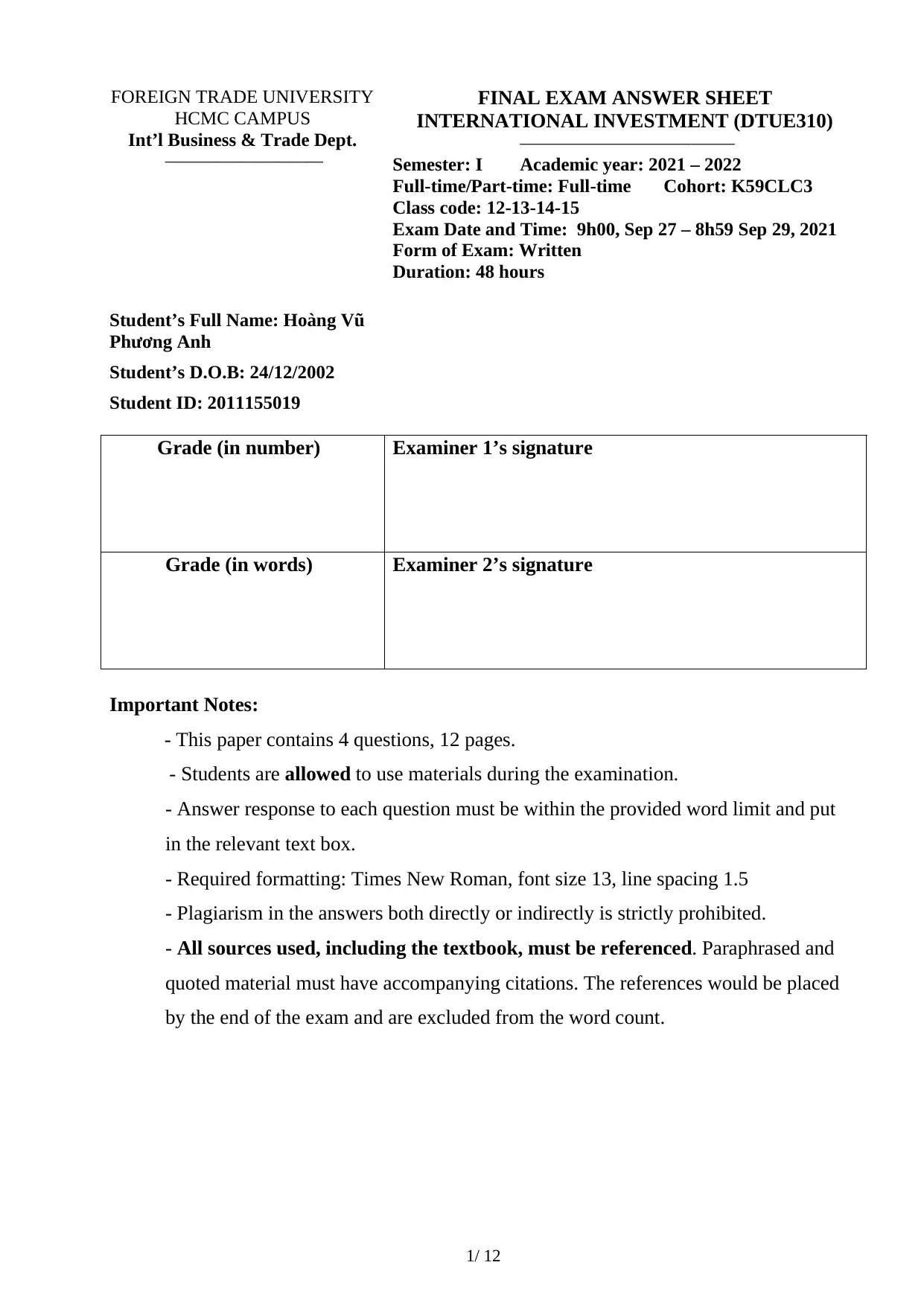
1/ 12
FOREIGN TRADE UNIVERSITY
HCMC CAMPUS
Int’l Business & Trade Dept.
_________________________
Student’s Full Name: Hoàng Vũ
Phương Anh
Student’s D.O.B: 24/12/2002
Student ID: 2011155019
FINAL EXAM ANSWER SHEET
INTERNATIONAL INVESTMENT (DTUE310)
__________________________________
Semester: I Academic year: 2021 – 2022
Full-time/Part-time: Full-time Cohort: K59CLC3
Class code: 12-13-14-15
Exam Date and Time: 9h00, Sep 27 – 8h59 Sep 29, 2021
Form of Exam: Written
Duration: 48 hours
Grade (in number) Examiner 1’s signature
Grade (in words) Examiner 2’s signature
Important Notes:
- This paper contains 4 questions, 12 pages.
- Students are allowed to use materials during the examination.
- Answer response to each question must be within the provided word limit and put
in the relevant text box.
- Required formatting: Times New Roman, font size 13, line spacing 1.5
- Plagiarism in the answers both directly or indirectly is strictly prohibited.
- All sources used, including the textbook, must be referenced. Paraphrased and
quoted material must have accompanying citations. The references would be placed
by the end of the exam and are excluded from the word count.
FOREIGN TRADE UNIVERSITY
HCMC CAMPUS
Int’l Business & Trade Dept.
_________________________
Student’s Full Name: Hoàng Vũ
Phương Anh
Student’s D.O.B: 24/12/2002
Student ID: 2011155019
FINAL EXAM ANSWER SHEET
INTERNATIONAL INVESTMENT (DTUE310)
__________________________________
Semester: I Academic year: 2021 – 2022
Full-time/Part-time: Full-time Cohort: K59CLC3
Class code: 12-13-14-15
Exam Date and Time: 9h00, Sep 27 – 8h59 Sep 29, 2021
Form of Exam: Written
Duration: 48 hours
Grade (in number) Examiner 1’s signature
Grade (in words) Examiner 2’s signature
Important Notes:
- This paper contains 4 questions, 12 pages.
- Students are allowed to use materials during the examination.
- Answer response to each question must be within the provided word limit and put
in the relevant text box.
- Required formatting: Times New Roman, font size 13, line spacing 1.5
- Plagiarism in the answers both directly or indirectly is strictly prohibited.
- All sources used, including the textbook, must be referenced. Paraphrased and
quoted material must have accompanying citations. The references would be placed
by the end of the exam and are excluded from the word count.
Paraphrase This Document
Need a fresh take? Get an instant paraphrase of this document with our AI Paraphraser
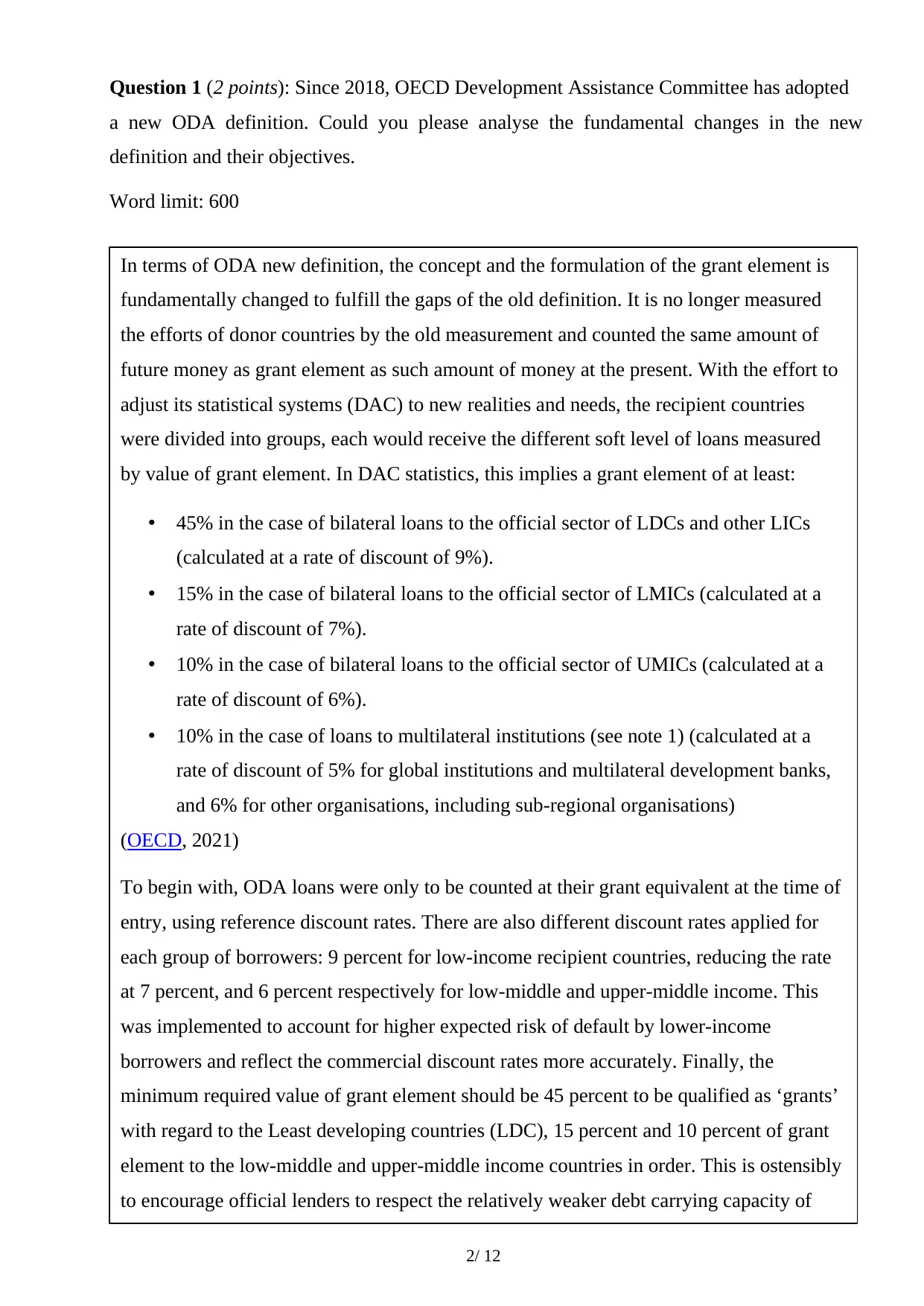
2/ 12
Question 1 (2 points): Since 2018, OECD Development Assistance Committee has adopted
a new ODA definition. Could you please analyse the fundamental changes in the new
definition and their objectives.
Word limit: 600
In terms of ODA new definition, the concept and the formulation of the grant element is
fundamentally changed to fulfill the gaps of the old definition. It is no longer measured
the efforts of donor countries by the old measurement and counted the same amount of
future money as grant element as such amount of money at the present. With the effort to
adjust its statistical systems (DAC) to new realities and needs, the recipient countries
were divided into groups, each would receive the different soft level of loans measured
by value of grant element. In DAC statistics, this implies a grant element of at least:
• 45% in the case of bilateral loans to the official sector of LDCs and other LICs
(calculated at a rate of discount of 9%).
• 15% in the case of bilateral loans to the official sector of LMICs (calculated at a
rate of discount of 7%).
• 10% in the case of bilateral loans to the official sector of UMICs (calculated at a
rate of discount of 6%).
• 10% in the case of loans to multilateral institutions (see note 1) (calculated at a
rate of discount of 5% for global institutions and multilateral development banks,
and 6% for other organisations, including sub-regional organisations)
(OECD, 2021)
To begin with, ODA loans were only to be counted at their grant equivalent at the time of
entry, using reference discount rates. There are also different discount rates applied for
each group of borrowers: 9 percent for low-income recipient countries, reducing the rate
at 7 percent, and 6 percent respectively for low-middle and upper-middle income. This
was implemented to account for higher expected risk of default by lower-income
borrowers and reflect the commercial discount rates more accurately. Finally, the
minimum required value of grant element should be 45 percent to be qualified as ‘grants’
with regard to the Least developing countries (LDC), 15 percent and 10 percent of grant
element to the low-middle and upper-middle income countries in order. This is ostensibly
to encourage official lenders to respect the relatively weaker debt carrying capacity of
Question 1 (2 points): Since 2018, OECD Development Assistance Committee has adopted
a new ODA definition. Could you please analyse the fundamental changes in the new
definition and their objectives.
Word limit: 600
In terms of ODA new definition, the concept and the formulation of the grant element is
fundamentally changed to fulfill the gaps of the old definition. It is no longer measured
the efforts of donor countries by the old measurement and counted the same amount of
future money as grant element as such amount of money at the present. With the effort to
adjust its statistical systems (DAC) to new realities and needs, the recipient countries
were divided into groups, each would receive the different soft level of loans measured
by value of grant element. In DAC statistics, this implies a grant element of at least:
• 45% in the case of bilateral loans to the official sector of LDCs and other LICs
(calculated at a rate of discount of 9%).
• 15% in the case of bilateral loans to the official sector of LMICs (calculated at a
rate of discount of 7%).
• 10% in the case of bilateral loans to the official sector of UMICs (calculated at a
rate of discount of 6%).
• 10% in the case of loans to multilateral institutions (see note 1) (calculated at a
rate of discount of 5% for global institutions and multilateral development banks,
and 6% for other organisations, including sub-regional organisations)
(OECD, 2021)
To begin with, ODA loans were only to be counted at their grant equivalent at the time of
entry, using reference discount rates. There are also different discount rates applied for
each group of borrowers: 9 percent for low-income recipient countries, reducing the rate
at 7 percent, and 6 percent respectively for low-middle and upper-middle income. This
was implemented to account for higher expected risk of default by lower-income
borrowers and reflect the commercial discount rates more accurately. Finally, the
minimum required value of grant element should be 45 percent to be qualified as ‘grants’
with regard to the Least developing countries (LDC), 15 percent and 10 percent of grant
element to the low-middle and upper-middle income countries in order. This is ostensibly
to encourage official lenders to respect the relatively weaker debt carrying capacity of
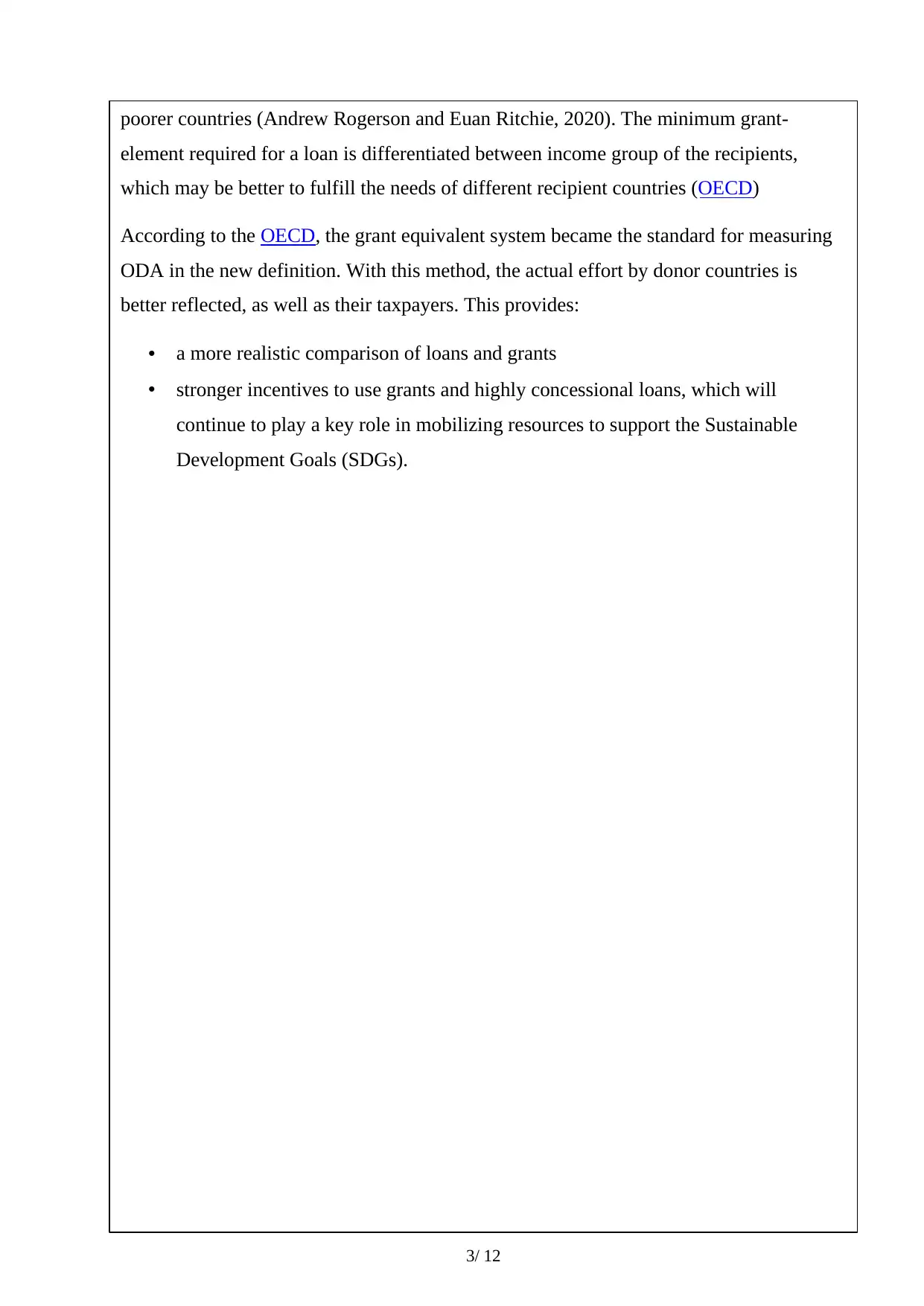
3/ 12
poorer countries (Andrew Rogerson and Euan Ritchie, 2020). The minimum grant-
element required for a loan is differentiated between income group of the recipients,
which may be better to fulfill the needs of different recipient countries (OECD)
According to the OECD, the grant equivalent system became the standard for measuring
ODA in the new definition. With this method, the actual effort by donor countries is
better reflected, as well as their taxpayers. This provides:
• a more realistic comparison of loans and grants
• stronger incentives to use grants and highly concessional loans, which will
continue to play a key role in mobilizing resources to support the Sustainable
Development Goals (SDGs).
poorer countries (Andrew Rogerson and Euan Ritchie, 2020). The minimum grant-
element required for a loan is differentiated between income group of the recipients,
which may be better to fulfill the needs of different recipient countries (OECD)
According to the OECD, the grant equivalent system became the standard for measuring
ODA in the new definition. With this method, the actual effort by donor countries is
better reflected, as well as their taxpayers. This provides:
• a more realistic comparison of loans and grants
• stronger incentives to use grants and highly concessional loans, which will
continue to play a key role in mobilizing resources to support the Sustainable
Development Goals (SDGs).
⊘ This is a preview!⊘
Do you want full access?
Subscribe today to unlock all pages.

Trusted by 1+ million students worldwide
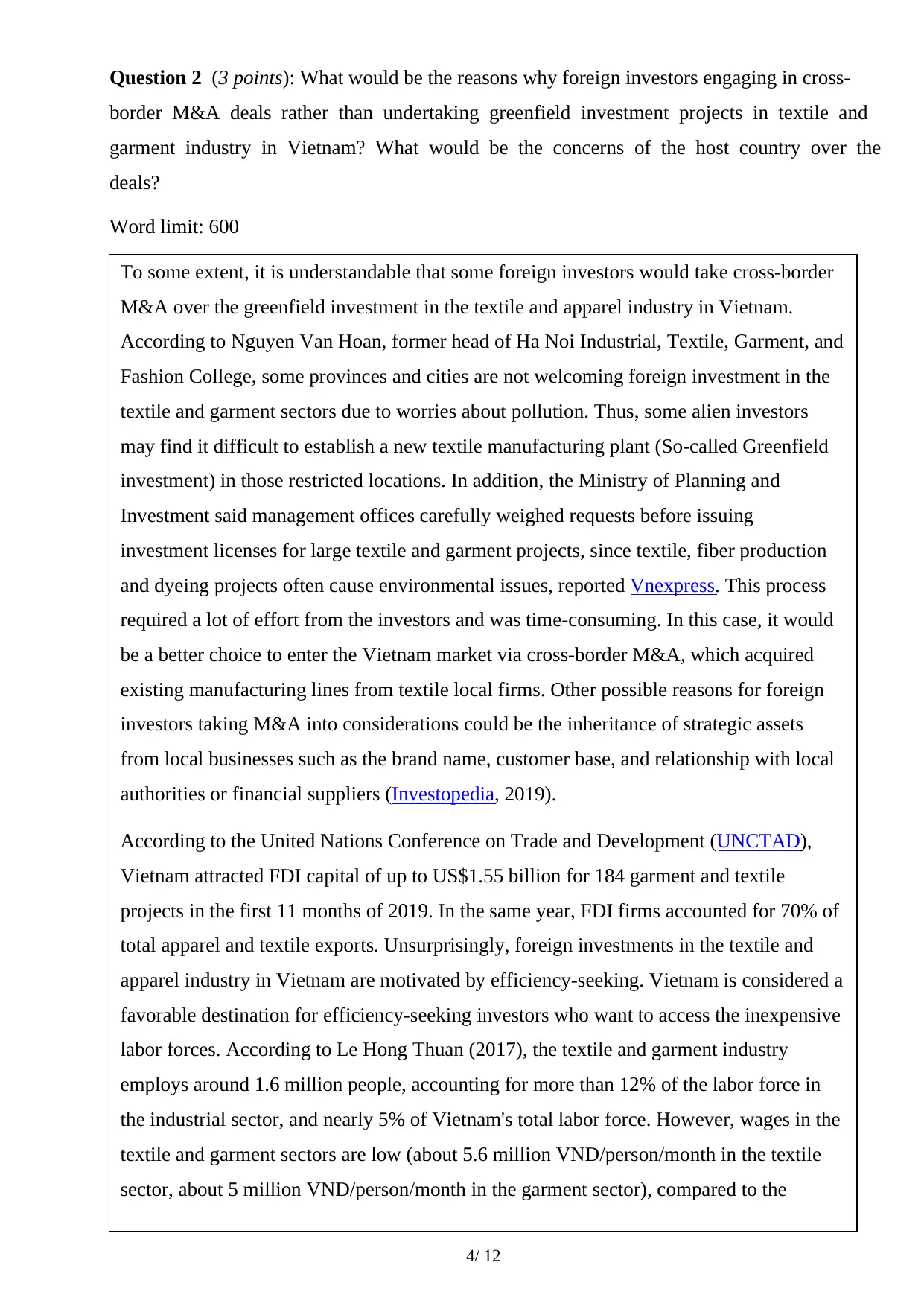
4/ 12
Question 2 (3 points): What would be the reasons why foreign investors engaging in cross-
border M&A deals rather than undertaking greenfield investment projects in textile and
garment industry in Vietnam? What would be the concerns of the host country over the
deals?
Word limit: 600
To some extent, it is understandable that some foreign investors would take cross-border
M&A over the greenfield investment in the textile and apparel industry in Vietnam.
According to Nguyen Van Hoan, former head of Ha Noi Industrial, Textile, Garment, and
Fashion College, some provinces and cities are not welcoming foreign investment in the
textile and garment sectors due to worries about pollution. Thus, some alien investors
may find it difficult to establish a new textile manufacturing plant (So-called Greenfield
investment) in those restricted locations. In addition, the Ministry of Planning and
Investment said management offices carefully weighed requests before issuing
investment licenses for large textile and garment projects, since textile, fiber production
and dyeing projects often cause environmental issues, reported Vnexpress. This process
required a lot of effort from the investors and was time-consuming. In this case, it would
be a better choice to enter the Vietnam market via cross-border M&A, which acquired
existing manufacturing lines from textile local firms. Other possible reasons for foreign
investors taking M&A into considerations could be the inheritance of strategic assets
from local businesses such as the brand name, customer base, and relationship with local
authorities or financial suppliers (Investopedia, 2019).
According to the United Nations Conference on Trade and Development (UNCTAD),
Vietnam attracted FDI capital of up to US$1.55 billion for 184 garment and textile
projects in the first 11 months of 2019. In the same year, FDI firms accounted for 70% of
total apparel and textile exports. Unsurprisingly, foreign investments in the textile and
apparel industry in Vietnam are motivated by efficiency-seeking. Vietnam is considered a
favorable destination for efficiency-seeking investors who want to access the inexpensive
labor forces. According to Le Hong Thuan (2017), the textile and garment industry
employs around 1.6 million people, accounting for more than 12% of the labor force in
the industrial sector, and nearly 5% of Vietnam's total labor force. However, wages in the
textile and garment sectors are low (about 5.6 million VND/person/month in the textile
sector, about 5 million VND/person/month in the garment sector), compared to the
Question 2 (3 points): What would be the reasons why foreign investors engaging in cross-
border M&A deals rather than undertaking greenfield investment projects in textile and
garment industry in Vietnam? What would be the concerns of the host country over the
deals?
Word limit: 600
To some extent, it is understandable that some foreign investors would take cross-border
M&A over the greenfield investment in the textile and apparel industry in Vietnam.
According to Nguyen Van Hoan, former head of Ha Noi Industrial, Textile, Garment, and
Fashion College, some provinces and cities are not welcoming foreign investment in the
textile and garment sectors due to worries about pollution. Thus, some alien investors
may find it difficult to establish a new textile manufacturing plant (So-called Greenfield
investment) in those restricted locations. In addition, the Ministry of Planning and
Investment said management offices carefully weighed requests before issuing
investment licenses for large textile and garment projects, since textile, fiber production
and dyeing projects often cause environmental issues, reported Vnexpress. This process
required a lot of effort from the investors and was time-consuming. In this case, it would
be a better choice to enter the Vietnam market via cross-border M&A, which acquired
existing manufacturing lines from textile local firms. Other possible reasons for foreign
investors taking M&A into considerations could be the inheritance of strategic assets
from local businesses such as the brand name, customer base, and relationship with local
authorities or financial suppliers (Investopedia, 2019).
According to the United Nations Conference on Trade and Development (UNCTAD),
Vietnam attracted FDI capital of up to US$1.55 billion for 184 garment and textile
projects in the first 11 months of 2019. In the same year, FDI firms accounted for 70% of
total apparel and textile exports. Unsurprisingly, foreign investments in the textile and
apparel industry in Vietnam are motivated by efficiency-seeking. Vietnam is considered a
favorable destination for efficiency-seeking investors who want to access the inexpensive
labor forces. According to Le Hong Thuan (2017), the textile and garment industry
employs around 1.6 million people, accounting for more than 12% of the labor force in
the industrial sector, and nearly 5% of Vietnam's total labor force. However, wages in the
textile and garment sectors are low (about 5.6 million VND/person/month in the textile
sector, about 5 million VND/person/month in the garment sector), compared to the
Paraphrase This Document
Need a fresh take? Get an instant paraphrase of this document with our AI Paraphraser
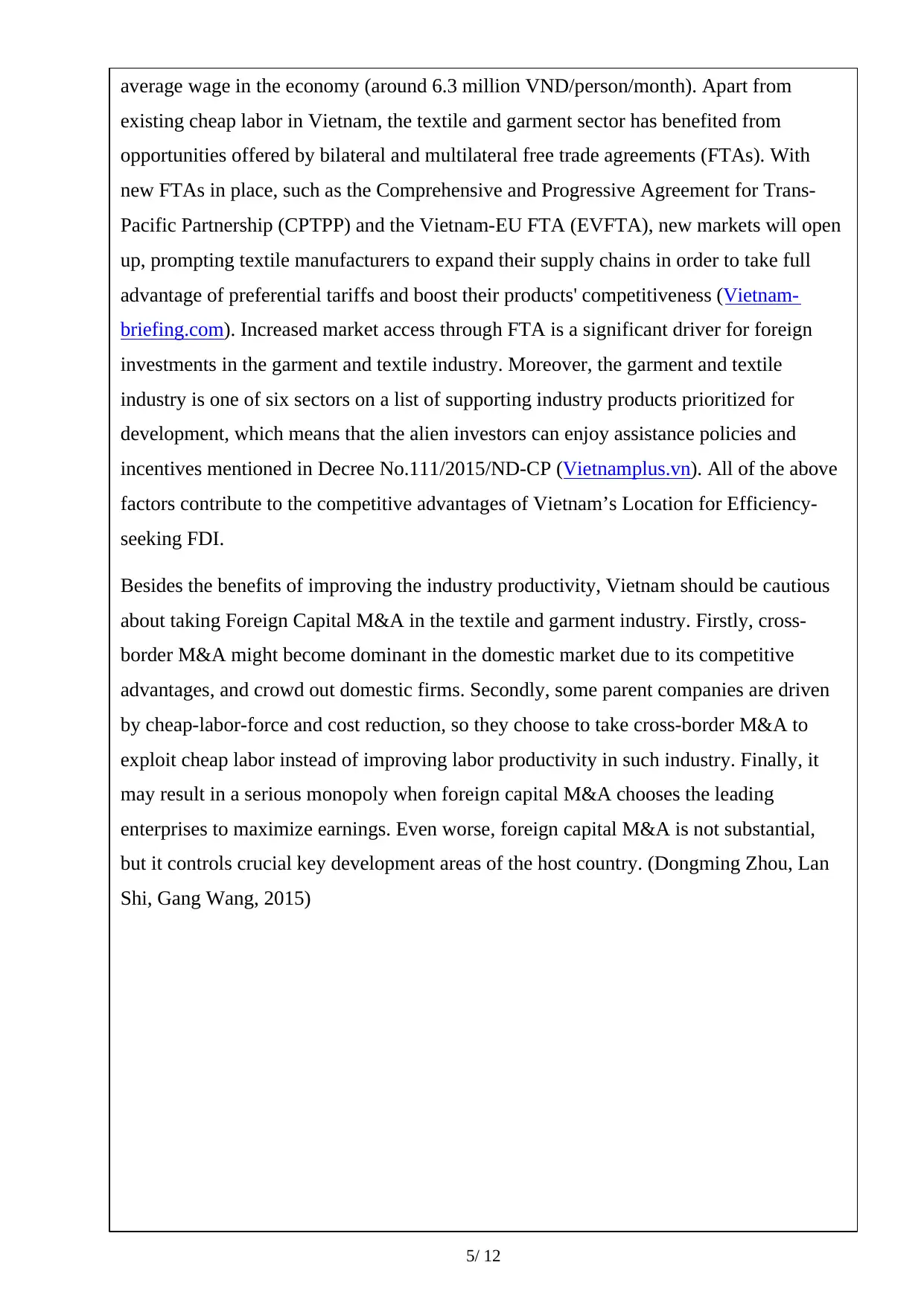
5/ 12
average wage in the economy (around 6.3 million VND/person/month). Apart from
existing cheap labor in Vietnam, the textile and garment sector has benefited from
opportunities offered by bilateral and multilateral free trade agreements (FTAs). With
new FTAs in place, such as the Comprehensive and Progressive Agreement for Trans-
Pacific Partnership (CPTPP) and the Vietnam-EU FTA (EVFTA), new markets will open
up, prompting textile manufacturers to expand their supply chains in order to take full
advantage of preferential tariffs and boost their products' competitiveness (Vietnam-
briefing.com). Increased market access through FTA is a significant driver for foreign
investments in the garment and textile industry. Moreover, the garment and textile
industry is one of six sectors on a list of supporting industry products prioritized for
development, which means that the alien investors can enjoy assistance policies and
incentives mentioned in Decree No.111/2015/ND-CP (Vietnamplus.vn). All of the above
factors contribute to the competitive advantages of Vietnam’s Location for Efficiency-
seeking FDI.
Besides the benefits of improving the industry productivity, Vietnam should be cautious
about taking Foreign Capital M&A in the textile and garment industry. Firstly, cross-
border M&A might become dominant in the domestic market due to its competitive
advantages, and crowd out domestic firms. Secondly, some parent companies are driven
by cheap-labor-force and cost reduction, so they choose to take cross-border M&A to
exploit cheap labor instead of improving labor productivity in such industry. Finally, it
may result in a serious monopoly when foreign capital M&A chooses the leading
enterprises to maximize earnings. Even worse, foreign capital M&A is not substantial,
but it controls crucial key development areas of the host country. (Dongming Zhou, Lan
Shi, Gang Wang, 2015)
average wage in the economy (around 6.3 million VND/person/month). Apart from
existing cheap labor in Vietnam, the textile and garment sector has benefited from
opportunities offered by bilateral and multilateral free trade agreements (FTAs). With
new FTAs in place, such as the Comprehensive and Progressive Agreement for Trans-
Pacific Partnership (CPTPP) and the Vietnam-EU FTA (EVFTA), new markets will open
up, prompting textile manufacturers to expand their supply chains in order to take full
advantage of preferential tariffs and boost their products' competitiveness (Vietnam-
briefing.com). Increased market access through FTA is a significant driver for foreign
investments in the garment and textile industry. Moreover, the garment and textile
industry is one of six sectors on a list of supporting industry products prioritized for
development, which means that the alien investors can enjoy assistance policies and
incentives mentioned in Decree No.111/2015/ND-CP (Vietnamplus.vn). All of the above
factors contribute to the competitive advantages of Vietnam’s Location for Efficiency-
seeking FDI.
Besides the benefits of improving the industry productivity, Vietnam should be cautious
about taking Foreign Capital M&A in the textile and garment industry. Firstly, cross-
border M&A might become dominant in the domestic market due to its competitive
advantages, and crowd out domestic firms. Secondly, some parent companies are driven
by cheap-labor-force and cost reduction, so they choose to take cross-border M&A to
exploit cheap labor instead of improving labor productivity in such industry. Finally, it
may result in a serious monopoly when foreign capital M&A chooses the leading
enterprises to maximize earnings. Even worse, foreign capital M&A is not substantial,
but it controls crucial key development areas of the host country. (Dongming Zhou, Lan
Shi, Gang Wang, 2015)
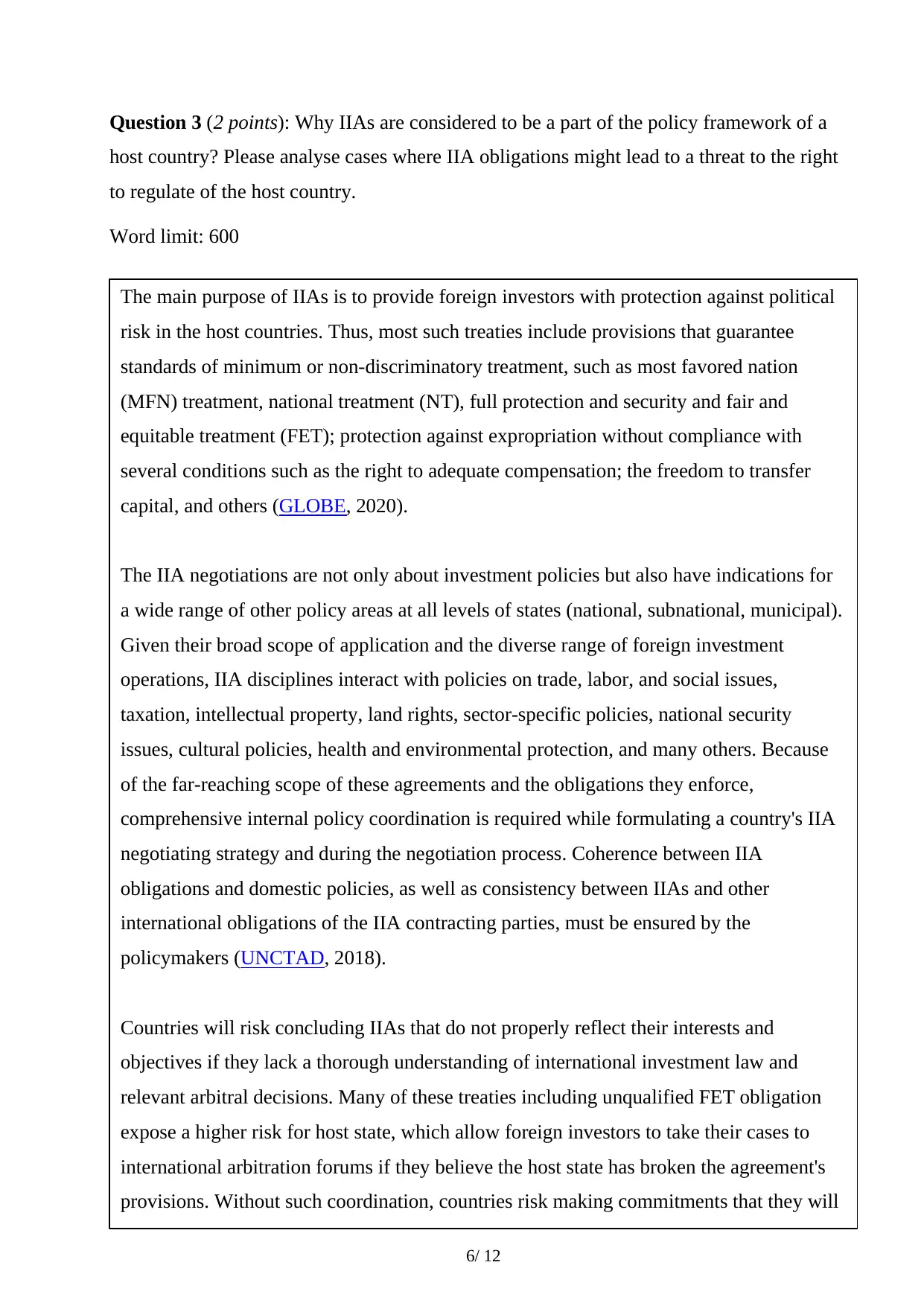
6/ 12
Question 3 (2 points): Why IIAs are considered to be a part of the policy framework of a
host country? Please analyse cases where IIA obligations might lead to a threat to the right
to regulate of the host country.
Word limit: 600
The main purpose of IIAs is to provide foreign investors with protection against political
risk in the host countries. Thus, most such treaties include provisions that guarantee
standards of minimum or non-discriminatory treatment, such as most favored nation
(MFN) treatment, national treatment (NT), full protection and security and fair and
equitable treatment (FET); protection against expropriation without compliance with
several conditions such as the right to adequate compensation; the freedom to transfer
capital, and others (GLOBE, 2020).
The IIA negotiations are not only about investment policies but also have indications for
a wide range of other policy areas at all levels of states (national, subnational, municipal).
Given their broad scope of application and the diverse range of foreign investment
operations, IIA disciplines interact with policies on trade, labor, and social issues,
taxation, intellectual property, land rights, sector-specific policies, national security
issues, cultural policies, health and environmental protection, and many others. Because
of the far-reaching scope of these agreements and the obligations they enforce,
comprehensive internal policy coordination is required while formulating a country's IIA
negotiating strategy and during the negotiation process. Coherence between IIA
obligations and domestic policies, as well as consistency between IIAs and other
international obligations of the IIA contracting parties, must be ensured by the
policymakers (UNCTAD, 2018).
Countries will risk concluding IIAs that do not properly reflect their interests and
objectives if they lack a thorough understanding of international investment law and
relevant arbitral decisions. Many of these treaties including unqualified FET obligation
expose a higher risk for host state, which allow foreign investors to take their cases to
international arbitration forums if they believe the host state has broken the agreement's
provisions. Without such coordination, countries risk making commitments that they will
Question 3 (2 points): Why IIAs are considered to be a part of the policy framework of a
host country? Please analyse cases where IIA obligations might lead to a threat to the right
to regulate of the host country.
Word limit: 600
The main purpose of IIAs is to provide foreign investors with protection against political
risk in the host countries. Thus, most such treaties include provisions that guarantee
standards of minimum or non-discriminatory treatment, such as most favored nation
(MFN) treatment, national treatment (NT), full protection and security and fair and
equitable treatment (FET); protection against expropriation without compliance with
several conditions such as the right to adequate compensation; the freedom to transfer
capital, and others (GLOBE, 2020).
The IIA negotiations are not only about investment policies but also have indications for
a wide range of other policy areas at all levels of states (national, subnational, municipal).
Given their broad scope of application and the diverse range of foreign investment
operations, IIA disciplines interact with policies on trade, labor, and social issues,
taxation, intellectual property, land rights, sector-specific policies, national security
issues, cultural policies, health and environmental protection, and many others. Because
of the far-reaching scope of these agreements and the obligations they enforce,
comprehensive internal policy coordination is required while formulating a country's IIA
negotiating strategy and during the negotiation process. Coherence between IIA
obligations and domestic policies, as well as consistency between IIAs and other
international obligations of the IIA contracting parties, must be ensured by the
policymakers (UNCTAD, 2018).
Countries will risk concluding IIAs that do not properly reflect their interests and
objectives if they lack a thorough understanding of international investment law and
relevant arbitral decisions. Many of these treaties including unqualified FET obligation
expose a higher risk for host state, which allow foreign investors to take their cases to
international arbitration forums if they believe the host state has broken the agreement's
provisions. Without such coordination, countries risk making commitments that they will
⊘ This is a preview!⊘
Do you want full access?
Subscribe today to unlock all pages.

Trusted by 1+ million students worldwide
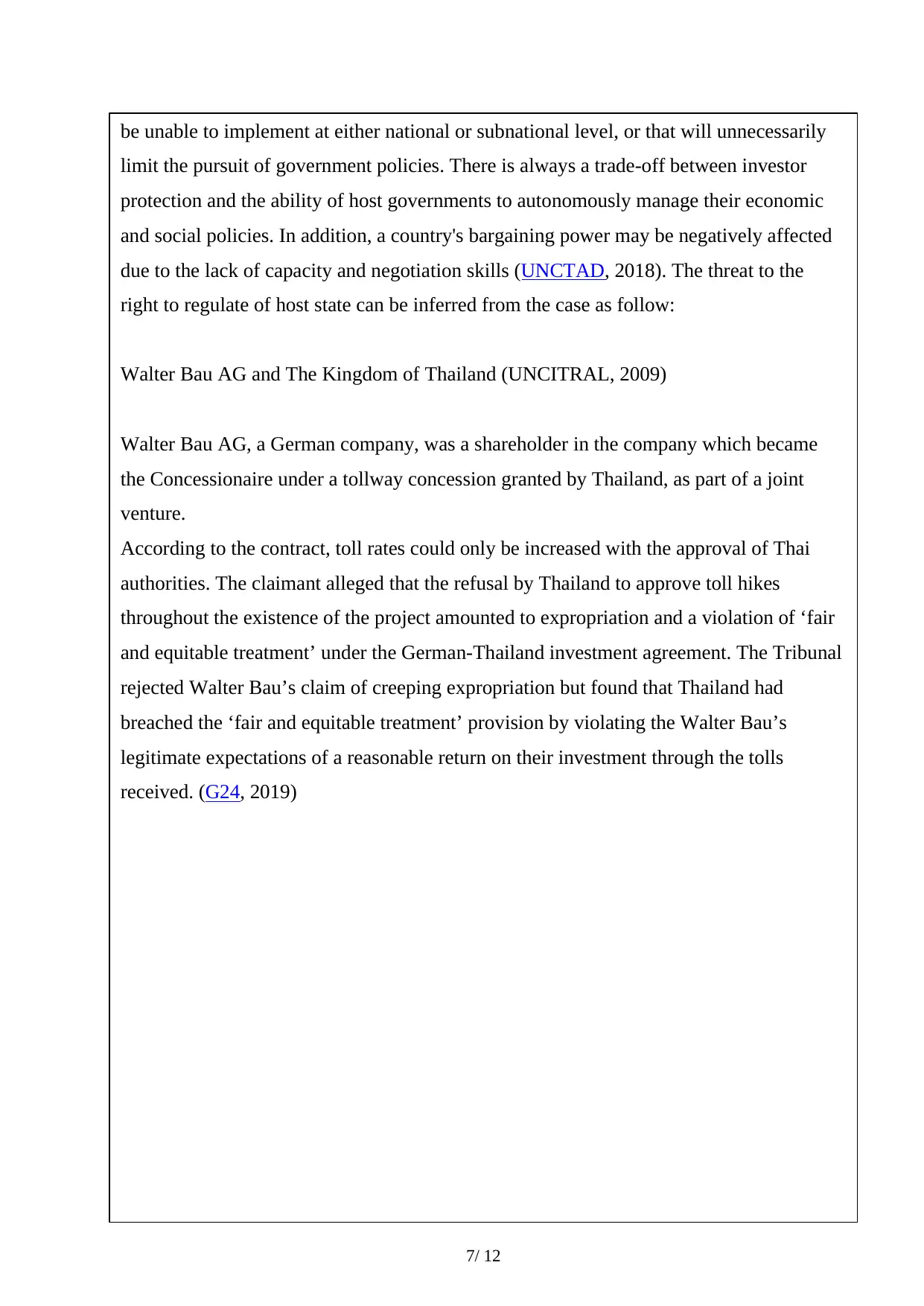
7/ 12
be unable to implement at either national or subnational level, or that will unnecessarily
limit the pursuit of government policies. There is always a trade-off between investor
protection and the ability of host governments to autonomously manage their economic
and social policies. In addition, a country's bargaining power may be negatively affected
due to the lack of capacity and negotiation skills (UNCTAD, 2018). The threat to the
right to regulate of host state can be inferred from the case as follow:
Walter Bau AG and The Kingdom of Thailand (UNCITRAL, 2009)
Walter Bau AG, a German company, was a shareholder in the company which became
the Concessionaire under a tollway concession granted by Thailand, as part of a joint
venture.
According to the contract, toll rates could only be increased with the approval of Thai
authorities. The claimant alleged that the refusal by Thailand to approve toll hikes
throughout the existence of the project amounted to expropriation and a violation of ‘fair
and equitable treatment’ under the German-Thailand investment agreement. The Tribunal
rejected Walter Bau’s claim of creeping expropriation but found that Thailand had
breached the ‘fair and equitable treatment’ provision by violating the Walter Bau’s
legitimate expectations of a reasonable return on their investment through the tolls
received. (G24, 2019)
be unable to implement at either national or subnational level, or that will unnecessarily
limit the pursuit of government policies. There is always a trade-off between investor
protection and the ability of host governments to autonomously manage their economic
and social policies. In addition, a country's bargaining power may be negatively affected
due to the lack of capacity and negotiation skills (UNCTAD, 2018). The threat to the
right to regulate of host state can be inferred from the case as follow:
Walter Bau AG and The Kingdom of Thailand (UNCITRAL, 2009)
Walter Bau AG, a German company, was a shareholder in the company which became
the Concessionaire under a tollway concession granted by Thailand, as part of a joint
venture.
According to the contract, toll rates could only be increased with the approval of Thai
authorities. The claimant alleged that the refusal by Thailand to approve toll hikes
throughout the existence of the project amounted to expropriation and a violation of ‘fair
and equitable treatment’ under the German-Thailand investment agreement. The Tribunal
rejected Walter Bau’s claim of creeping expropriation but found that Thailand had
breached the ‘fair and equitable treatment’ provision by violating the Walter Bau’s
legitimate expectations of a reasonable return on their investment through the tolls
received. (G24, 2019)
Paraphrase This Document
Need a fresh take? Get an instant paraphrase of this document with our AI Paraphraser
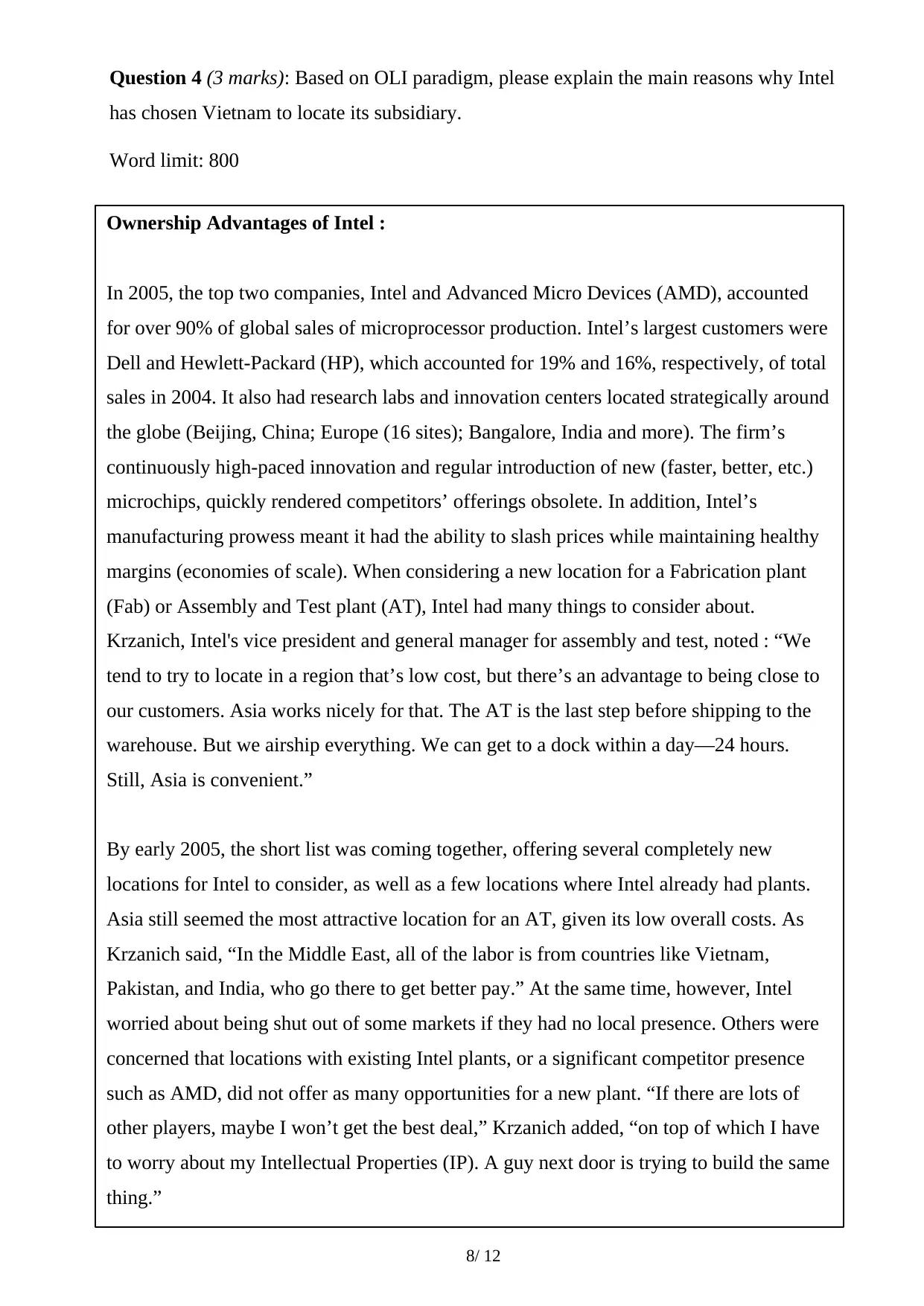
8/ 12
Question 4 (3 marks): Based on OLI paradigm, please explain the main reasons why Intel
has chosen Vietnam to locate its subsidiary.
Word limit: 800
Ownership Advantages of Intel :
In 2005, the top two companies, Intel and Advanced Micro Devices (AMD), accounted
for over 90% of global sales of microprocessor production. Intel’s largest customers were
Dell and Hewlett-Packard (HP), which accounted for 19% and 16%, respectively, of total
sales in 2004. It also had research labs and innovation centers located strategically around
the globe (Beijing, China; Europe (16 sites); Bangalore, India and more). The firm’s
continuously high-paced innovation and regular introduction of new (faster, better, etc.)
microchips, quickly rendered competitors’ offerings obsolete. In addition, Intel’s
manufacturing prowess meant it had the ability to slash prices while maintaining healthy
margins (economies of scale). When considering a new location for a Fabrication plant
(Fab) or Assembly and Test plant (AT), Intel had many things to consider about.
Krzanich, Intel's vice president and general manager for assembly and test, noted : “We
tend to try to locate in a region that’s low cost, but there’s an advantage to being close to
our customers. Asia works nicely for that. The AT is the last step before shipping to the
warehouse. But we airship everything. We can get to a dock within a day—24 hours.
Still, Asia is convenient.”
By early 2005, the short list was coming together, offering several completely new
locations for Intel to consider, as well as a few locations where Intel already had plants.
Asia still seemed the most attractive location for an AT, given its low overall costs. As
Krzanich said, “In the Middle East, all of the labor is from countries like Vietnam,
Pakistan, and India, who go there to get better pay.” At the same time, however, Intel
worried about being shut out of some markets if they had no local presence. Others were
concerned that locations with existing Intel plants, or a significant competitor presence
such as AMD, did not offer as many opportunities for a new plant. “If there are lots of
other players, maybe I won’t get the best deal,” Krzanich added, “on top of which I have
to worry about my Intellectual Properties (IP). A guy next door is trying to build the same
thing.”
Question 4 (3 marks): Based on OLI paradigm, please explain the main reasons why Intel
has chosen Vietnam to locate its subsidiary.
Word limit: 800
Ownership Advantages of Intel :
In 2005, the top two companies, Intel and Advanced Micro Devices (AMD), accounted
for over 90% of global sales of microprocessor production. Intel’s largest customers were
Dell and Hewlett-Packard (HP), which accounted for 19% and 16%, respectively, of total
sales in 2004. It also had research labs and innovation centers located strategically around
the globe (Beijing, China; Europe (16 sites); Bangalore, India and more). The firm’s
continuously high-paced innovation and regular introduction of new (faster, better, etc.)
microchips, quickly rendered competitors’ offerings obsolete. In addition, Intel’s
manufacturing prowess meant it had the ability to slash prices while maintaining healthy
margins (economies of scale). When considering a new location for a Fabrication plant
(Fab) or Assembly and Test plant (AT), Intel had many things to consider about.
Krzanich, Intel's vice president and general manager for assembly and test, noted : “We
tend to try to locate in a region that’s low cost, but there’s an advantage to being close to
our customers. Asia works nicely for that. The AT is the last step before shipping to the
warehouse. But we airship everything. We can get to a dock within a day—24 hours.
Still, Asia is convenient.”
By early 2005, the short list was coming together, offering several completely new
locations for Intel to consider, as well as a few locations where Intel already had plants.
Asia still seemed the most attractive location for an AT, given its low overall costs. As
Krzanich said, “In the Middle East, all of the labor is from countries like Vietnam,
Pakistan, and India, who go there to get better pay.” At the same time, however, Intel
worried about being shut out of some markets if they had no local presence. Others were
concerned that locations with existing Intel plants, or a significant competitor presence
such as AMD, did not offer as many opportunities for a new plant. “If there are lots of
other players, maybe I won’t get the best deal,” Krzanich added, “on top of which I have
to worry about my Intellectual Properties (IP). A guy next door is trying to build the same
thing.”
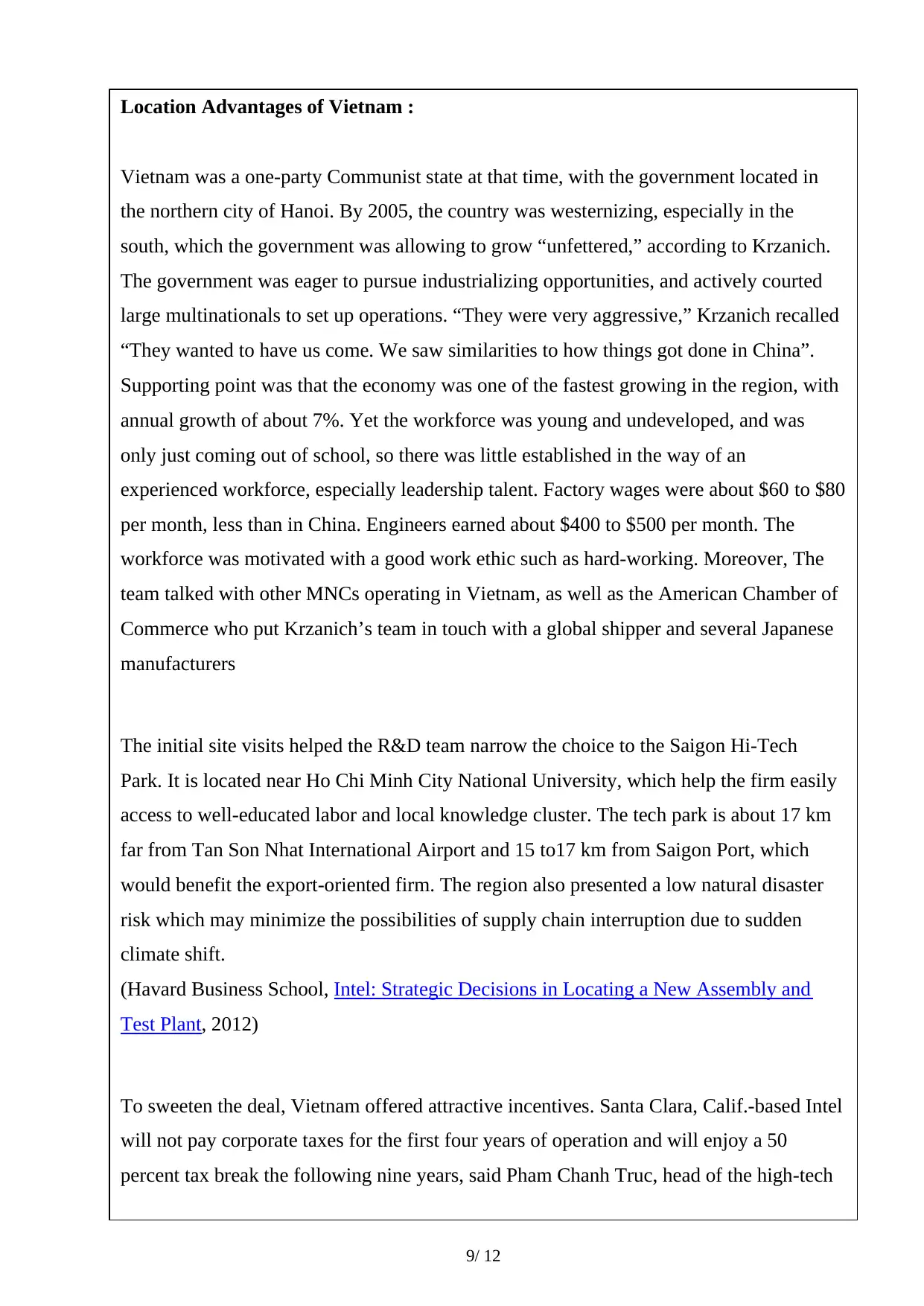
9/ 12
Location Advantages of Vietnam :
Vietnam was a one-party Communist state at that time, with the government located in
the northern city of Hanoi. By 2005, the country was westernizing, especially in the
south, which the government was allowing to grow “unfettered,” according to Krzanich.
The government was eager to pursue industrializing opportunities, and actively courted
large multinationals to set up operations. “They were very aggressive,” Krzanich recalled
“They wanted to have us come. We saw similarities to how things got done in China”.
Supporting point was that the economy was one of the fastest growing in the region, with
annual growth of about 7%. Yet the workforce was young and undeveloped, and was
only just coming out of school, so there was little established in the way of an
experienced workforce, especially leadership talent. Factory wages were about $60 to $80
per month, less than in China. Engineers earned about $400 to $500 per month. The
workforce was motivated with a good work ethic such as hard-working. Moreover, The
team talked with other MNCs operating in Vietnam, as well as the American Chamber of
Commerce who put Krzanich’s team in touch with a global shipper and several Japanese
manufacturers
The initial site visits helped the R&D team narrow the choice to the Saigon Hi-Tech
Park. It is located near Ho Chi Minh City National University, which help the firm easily
access to well-educated labor and local knowledge cluster. The tech park is about 17 km
far from Tan Son Nhat International Airport and 15 to17 km from Saigon Port, which
would benefit the export-oriented firm. The region also presented a low natural disaster
risk which may minimize the possibilities of supply chain interruption due to sudden
climate shift.
(Havard Business School, Intel: Strategic Decisions in Locating a New Assembly and
Test Plant, 2012)
To sweeten the deal, Vietnam offered attractive incentives. Santa Clara, Calif.-based Intel
will not pay corporate taxes for the first four years of operation and will enjoy a 50
percent tax break the following nine years, said Pham Chanh Truc, head of the high-tech
Location Advantages of Vietnam :
Vietnam was a one-party Communist state at that time, with the government located in
the northern city of Hanoi. By 2005, the country was westernizing, especially in the
south, which the government was allowing to grow “unfettered,” according to Krzanich.
The government was eager to pursue industrializing opportunities, and actively courted
large multinationals to set up operations. “They were very aggressive,” Krzanich recalled
“They wanted to have us come. We saw similarities to how things got done in China”.
Supporting point was that the economy was one of the fastest growing in the region, with
annual growth of about 7%. Yet the workforce was young and undeveloped, and was
only just coming out of school, so there was little established in the way of an
experienced workforce, especially leadership talent. Factory wages were about $60 to $80
per month, less than in China. Engineers earned about $400 to $500 per month. The
workforce was motivated with a good work ethic such as hard-working. Moreover, The
team talked with other MNCs operating in Vietnam, as well as the American Chamber of
Commerce who put Krzanich’s team in touch with a global shipper and several Japanese
manufacturers
The initial site visits helped the R&D team narrow the choice to the Saigon Hi-Tech
Park. It is located near Ho Chi Minh City National University, which help the firm easily
access to well-educated labor and local knowledge cluster. The tech park is about 17 km
far from Tan Son Nhat International Airport and 15 to17 km from Saigon Port, which
would benefit the export-oriented firm. The region also presented a low natural disaster
risk which may minimize the possibilities of supply chain interruption due to sudden
climate shift.
(Havard Business School, Intel: Strategic Decisions in Locating a New Assembly and
Test Plant, 2012)
To sweeten the deal, Vietnam offered attractive incentives. Santa Clara, Calif.-based Intel
will not pay corporate taxes for the first four years of operation and will enjoy a 50
percent tax break the following nine years, said Pham Chanh Truc, head of the high-tech
⊘ This is a preview!⊘
Do you want full access?
Subscribe today to unlock all pages.

Trusted by 1+ million students worldwide
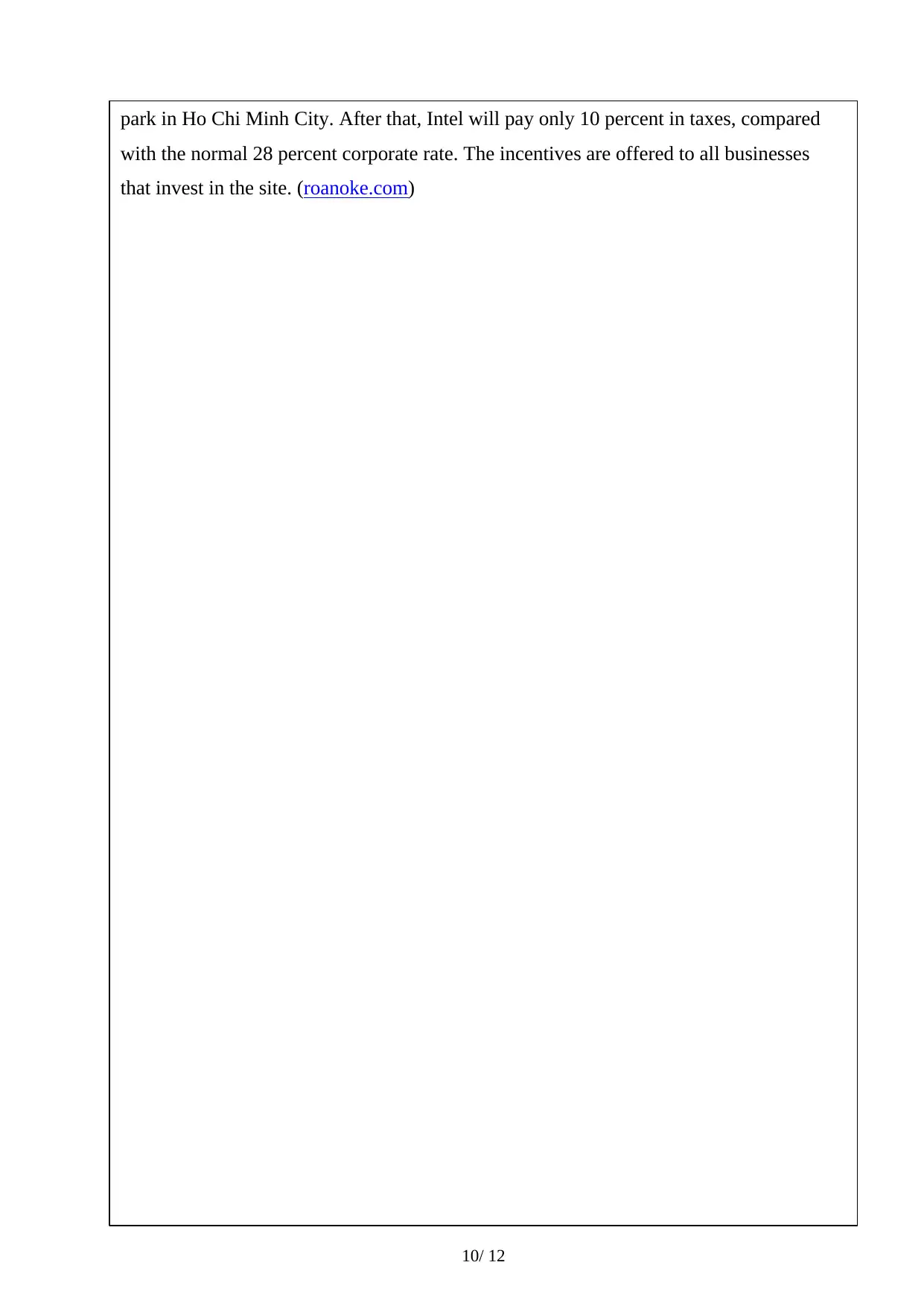
10/ 12
park in Ho Chi Minh City. After that, Intel will pay only 10 percent in taxes, compared
with the normal 28 percent corporate rate. The incentives are offered to all businesses
that invest in the site. (roanoke.com)
park in Ho Chi Minh City. After that, Intel will pay only 10 percent in taxes, compared
with the normal 28 percent corporate rate. The incentives are offered to all businesses
that invest in the site. (roanoke.com)
Paraphrase This Document
Need a fresh take? Get an instant paraphrase of this document with our AI Paraphraser
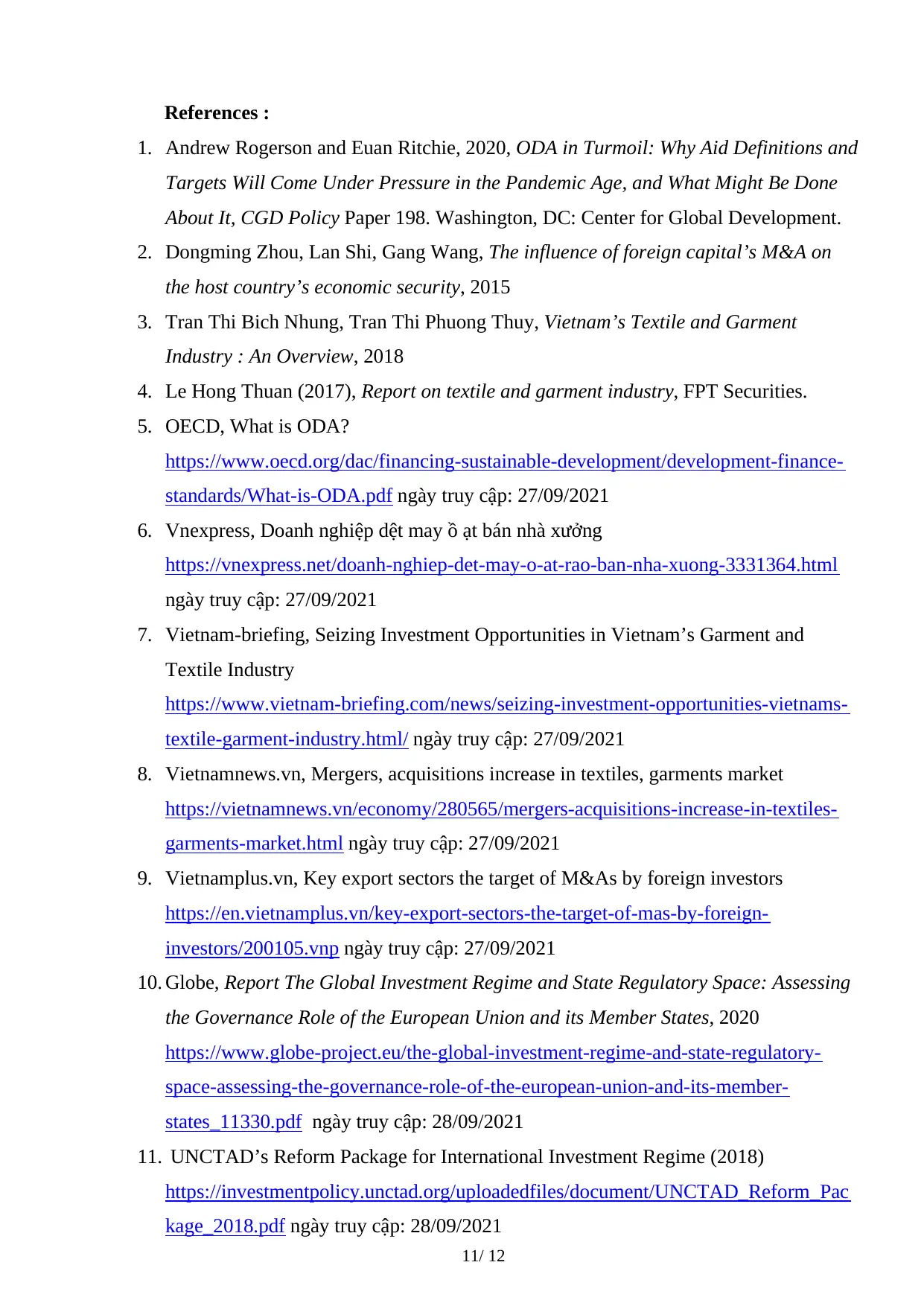
11/ 12
References :
1. Andrew Rogerson and Euan Ritchie, 2020, ODA in Turmoil: Why Aid Definitions and
Targets Will Come Under Pressure in the Pandemic Age, and What Might Be Done
About It, CGD Policy Paper 198. Washington, DC: Center for Global Development.
2. Dongming Zhou, Lan Shi, Gang Wang, The influence of foreign capital’s M&A on
the host country’s economic security, 2015
3. Tran Thi Bich Nhung, Tran Thi Phuong Thuy, Vietnam’s Textile and Garment
Industry : An Overview, 2018
4. Le Hong Thuan (2017), Report on textile and garment industry, FPT Securities.
5. OECD, What is ODA?
https://www.oecd.org/dac/financing-sustainable-development/development-finance-
standards/What-is-ODA.pdf ngày truy cập: 27/09/2021
6. Vnexpress, Doanh nghiệp dệt may ồ ạt bán nhà xưởng
https://vnexpress.net/doanh-nghiep-det-may-o-at-rao-ban-nha-xuong-3331364.html
ngày truy cập: 27/09/2021
7. Vietnam-briefing, Seizing Investment Opportunities in Vietnam’s Garment and
Textile Industry
https://www.vietnam-briefing.com/news/seizing-investment-opportunities-vietnams-
textile-garment-industry.html/ ngày truy cập: 27/09/2021
8. Vietnamnews.vn, Mergers, acquisitions increase in textiles, garments market
https://vietnamnews.vn/economy/280565/mergers-acquisitions-increase-in-textiles-
garments-market.html ngày truy cập: 27/09/2021
9. Vietnamplus.vn, Key export sectors the target of M&As by foreign investors
https://en.vietnamplus.vn/key-export-sectors-the-target-of-mas-by-foreign-
investors/200105.vnp ngày truy cập: 27/09/2021
10. Globe, Report The Global Investment Regime and State Regulatory Space: Assessing
the Governance Role of the European Union and its Member States, 2020
https://www.globe-project.eu/the-global-investment-regime-and-state-regulatory-
space-assessing-the-governance-role-of-the-european-union-and-its-member-
states_11330.pdf ngày truy cập: 28/09/2021
11. UNCTAD’s Reform Package for International Investment Regime (2018)
https://investmentpolicy.unctad.org/uploadedfiles/document/UNCTAD_Reform_Pac
kage_2018.pdf ngày truy cập: 28/09/2021
References :
1. Andrew Rogerson and Euan Ritchie, 2020, ODA in Turmoil: Why Aid Definitions and
Targets Will Come Under Pressure in the Pandemic Age, and What Might Be Done
About It, CGD Policy Paper 198. Washington, DC: Center for Global Development.
2. Dongming Zhou, Lan Shi, Gang Wang, The influence of foreign capital’s M&A on
the host country’s economic security, 2015
3. Tran Thi Bich Nhung, Tran Thi Phuong Thuy, Vietnam’s Textile and Garment
Industry : An Overview, 2018
4. Le Hong Thuan (2017), Report on textile and garment industry, FPT Securities.
5. OECD, What is ODA?
https://www.oecd.org/dac/financing-sustainable-development/development-finance-
standards/What-is-ODA.pdf ngày truy cập: 27/09/2021
6. Vnexpress, Doanh nghiệp dệt may ồ ạt bán nhà xưởng
https://vnexpress.net/doanh-nghiep-det-may-o-at-rao-ban-nha-xuong-3331364.html
ngày truy cập: 27/09/2021
7. Vietnam-briefing, Seizing Investment Opportunities in Vietnam’s Garment and
Textile Industry
https://www.vietnam-briefing.com/news/seizing-investment-opportunities-vietnams-
textile-garment-industry.html/ ngày truy cập: 27/09/2021
8. Vietnamnews.vn, Mergers, acquisitions increase in textiles, garments market
https://vietnamnews.vn/economy/280565/mergers-acquisitions-increase-in-textiles-
garments-market.html ngày truy cập: 27/09/2021
9. Vietnamplus.vn, Key export sectors the target of M&As by foreign investors
https://en.vietnamplus.vn/key-export-sectors-the-target-of-mas-by-foreign-
investors/200105.vnp ngày truy cập: 27/09/2021
10. Globe, Report The Global Investment Regime and State Regulatory Space: Assessing
the Governance Role of the European Union and its Member States, 2020
https://www.globe-project.eu/the-global-investment-regime-and-state-regulatory-
space-assessing-the-governance-role-of-the-european-union-and-its-member-
states_11330.pdf ngày truy cập: 28/09/2021
11. UNCTAD’s Reform Package for International Investment Regime (2018)
https://investmentpolicy.unctad.org/uploadedfiles/document/UNCTAD_Reform_Pac
kage_2018.pdf ngày truy cập: 28/09/2021
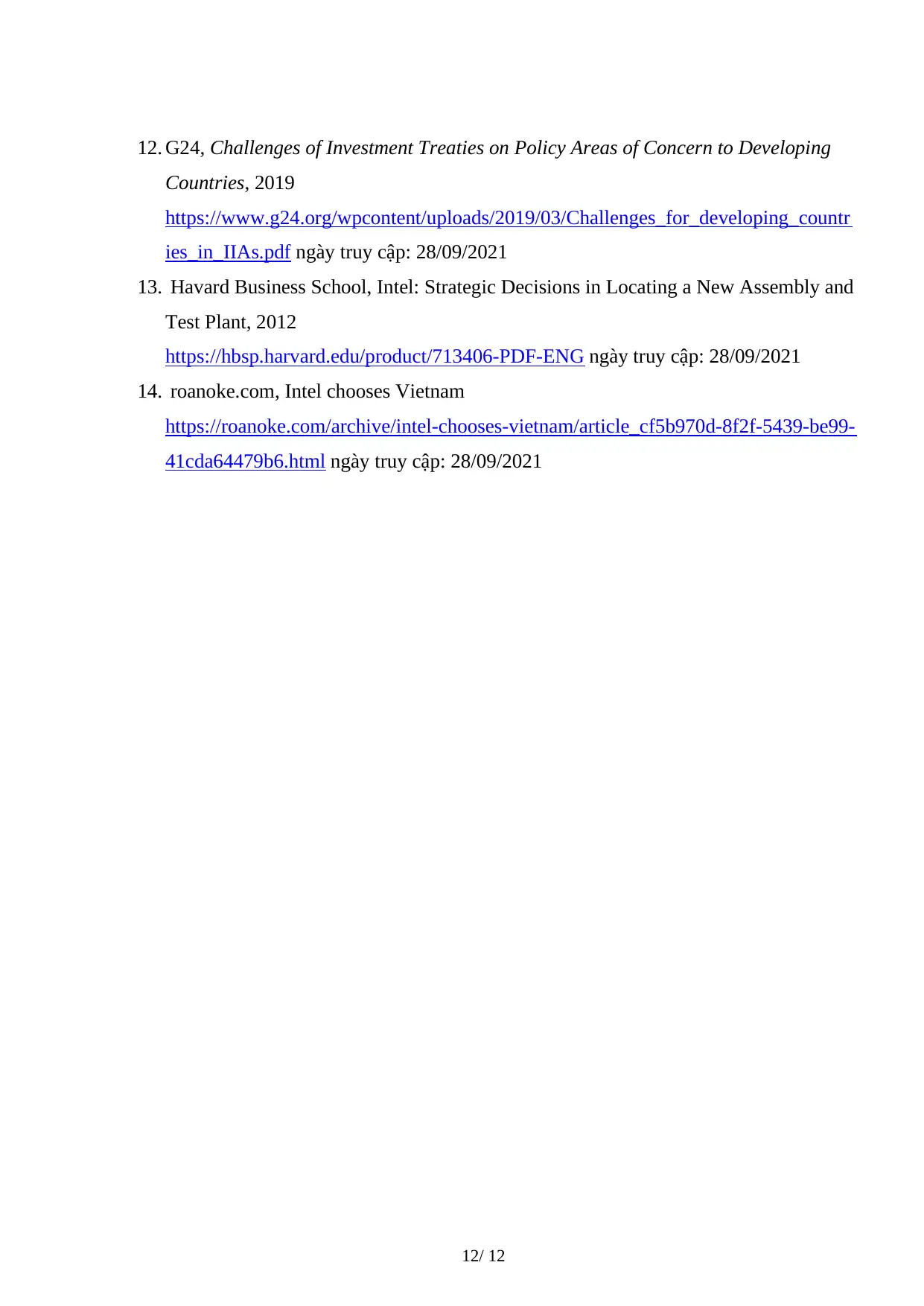
12/ 12
12. G24, Challenges of Investment Treaties on Policy Areas of Concern to Developing
Countries, 2019
https://www.g24.org/wpcontent/uploads/2019/03/Challenges_for_developing_countr
ies_in_IIAs.pdf ngày truy cập: 28/09/2021
13. Havard Business School, Intel: Strategic Decisions in Locating a New Assembly and
Test Plant, 2012
https://hbsp.harvard.edu/product/713406-PDF-ENG ngày truy cập: 28/09/2021
14. roanoke.com, Intel chooses Vietnam
https://roanoke.com/archive/intel-chooses-vietnam/article_cf5b970d-8f2f-5439-be99-
41cda64479b6.html ngày truy cập: 28/09/2021
12. G24, Challenges of Investment Treaties on Policy Areas of Concern to Developing
Countries, 2019
https://www.g24.org/wpcontent/uploads/2019/03/Challenges_for_developing_countr
ies_in_IIAs.pdf ngày truy cập: 28/09/2021
13. Havard Business School, Intel: Strategic Decisions in Locating a New Assembly and
Test Plant, 2012
https://hbsp.harvard.edu/product/713406-PDF-ENG ngày truy cập: 28/09/2021
14. roanoke.com, Intel chooses Vietnam
https://roanoke.com/archive/intel-chooses-vietnam/article_cf5b970d-8f2f-5439-be99-
41cda64479b6.html ngày truy cập: 28/09/2021
⊘ This is a preview!⊘
Do you want full access?
Subscribe today to unlock all pages.

Trusted by 1+ million students worldwide
1 out of 12
Your All-in-One AI-Powered Toolkit for Academic Success.
+13062052269
info@desklib.com
Available 24*7 on WhatsApp / Email
![[object Object]](/_next/static/media/star-bottom.7253800d.svg)
Unlock your academic potential
Copyright © 2020–2025 A2Z Services. All Rights Reserved. Developed and managed by ZUCOL.